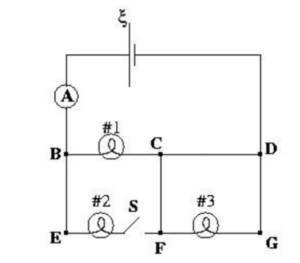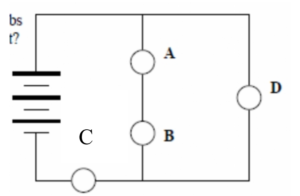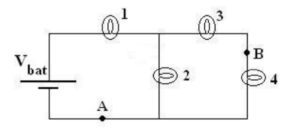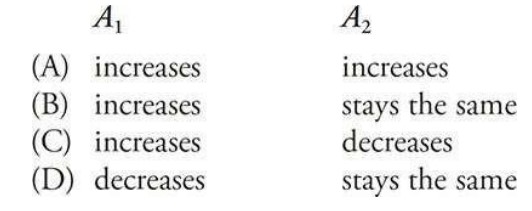Question

In the circuit above, with the switch closed, what will voltmeter \(V\) read? (\(A\) is an ammeter.) Select two answers.
(A) The voltage drop across \(R_{1}\)
(B) The voltage drop across ammeter \(A\)
(C) The voltage drop across \(R_{2}\)
(D) Zero
▶️Answer/Explanation
Ans:
(A) and (C) Both \(R_{1}\) and \(R_{2}\) are connected in parallel to the same two points that the voltmeter is measuring the potential difference between. Therefore, the voltmeter reading is that same voltage drop for both \(R_{1}\) and \(R_{2}\). Note that an ideal ammeter has no resistance and thus experiences no voltage drop itself.
Question

For the circuit shown, the ammeter reading is initially I. The switch in the circuit then is closed. Consequently:
(A) The ammeter reading decreases.
(B) The potential difference between E and F increases.
(C) The potential difference between E and F stays the same.
(D) Bulb #3 lights up more brightly.
▶️Answer/Explanation
Ans:C
Solution: Wire CD shorts out bulb #3 so it will never light. Closing the switch merely adds bulb #2 in parallel to bulb #1, which does not change the potential difference across bulb #1.
Question

In the circuit diagram to the left, all of the bulbs are identical. Which bulb will be the brightest?
(A) A (B) B (C) C (D) D
▶️Answer/Explanation
Ans:C
Solution: Bulb C in the main branch receiving the total current will be the brightest
Question

For the circuit shown, when a shorting wire (no resistance) connects the points labeled A and B, which of the numbered light bulbs become brighter? Assume that all four bulbs are identical and have resistance R .
(A) Bulb 2 only (B) Bulb 3 only (C) Bulbs 1 and 3 only (D) Bulbs 1, 2, and 3
▶️Answer/Explanation
Ans:C
Solution: Shorting bulb 4 decreases the resistance in the right branch, increasing the current through bulb 3 and in the main branch containing bulb 1.
Question

The circuit shown has a battery of emf e; three identical resistors, R; two ammeters, \(A_{1}\) and \(A_{2}\); and a switch that is initially in the open position as shown in the figure. When the switch is closed, what happens to the current reading in the two ammeters?

▶️Answer/Explanation
Ans:
C—With the switch open, the circuit is a simple series circuit with an equivalent resistance of 2fi. Both ammeters will receive the same current:
\(I=\frac{V}{R}=\frac{\varepsilon }{2R}\)
When the switch is closed, the two resistors in parallel on the right add to give \(\frac{1}{2}\)fi, which, when added in series to the resistor in the main line, gives a new equivalent resistance for the circuit of \(\frac{3}{2}\)fi. This will give a new, larger total current passing through the battery and ammeter \(A_{T}\):
\(I_{T}=I_{A_{1}}=\frac{V}{R}=\frac{\varepsilon }{\frac{3}{2}R}=\frac{2\varepsilon }{3R}\)
Ammeter \(fi_{2}\), however, receives only half of this total current as the total current splits evenly to pass through each of the parallel section on the right of the circuit:
\(I_{P}=I_{A_{2}}=\frac{I_{A_{1}}}{2}=\frac{2\varepsilon }{6R}=\frac{1\varepsilon }{3R}\)
Thus, the current in \(A_{2}\) decreases when the switch is closed.
